Clematis Purpurea Plena Elegance - a detailed description of the variety
Clematis Purpurea Plena Elegans (lat.Purpurea Plena Elegans) was bred in 1899 by the French originator Francis Morel. This is the most beautiful variety from the Viticella group according to the estimates of breeders around the world. Medium in height, with large double flowers, this hybrid is a real decoration of the French clematis series.
- general description
- Landing features
- Seat selection
- Preparation of planting material
- Landing technology
- Care
- Pruning
- Watering
- Top dressing
- Shelter for the winter
- Spring water protection
- Support
- Mulching and loosening the soil
- Reproduction
- Division of bushes
- Layers
- Cuttings
- Diseases and pests
- Rot
- Powdery mildew
- Harmful insects
- Rodents
- Use in landscape design
- Variety reviews
- Useful videos
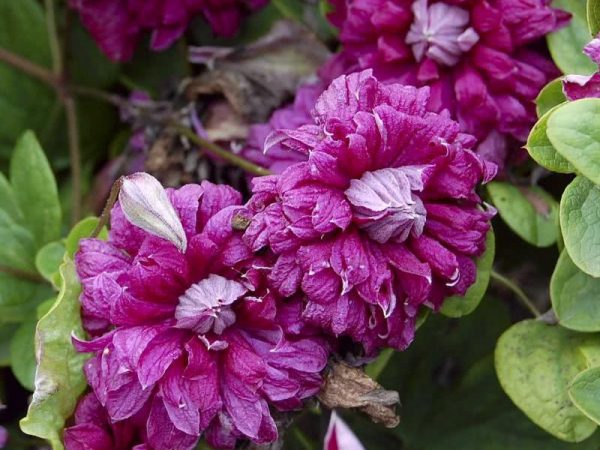
Clematis purpurea captivity elegance
general description
The plant has a fast green mass gain. Shoots can grow up to 4 meters in just a month with sufficient nutrient content in the soil, regular watering and good lighting. Stems are thin and flexible, the leaves are elongated, dark, up to 10 cm long. The leaf petioles are long, easily twisted around any support - mesh, wall or arch.
The flowers of this hybrid are extremely decorative - large and double, up to 12 cm in diameter. In addition, there are a lot of them on the bush. Each shoot produces up to 120 buds, making the entire bush look like a solid lilac-purple floral carpet. Flowering lasts from June to September. Buds are formed only on young shoots that have grown after winter.
The flowers of this variety have several characteristics.
- They do not have stamens at all, which is unusual for clematis.
- The buds can change color depending on the conditions. These changes are influenced by a change in soil acidity, brightness of lighting, and moisture. The higher these indicators, the brighter the flowers will be. It has also been noticed that they "fade" over time and become paler by the end of the season.
Landing features
You can plant clematis in open ground both in April and in September, depending on the climatic zone. In warm latitudes, the plant is ready for planting at any time from spring to autumn, in colder areas it is better to plant a bush in spring. Over the summer, clematis will strengthen and grow new roots, so it will be easier for it to winter.
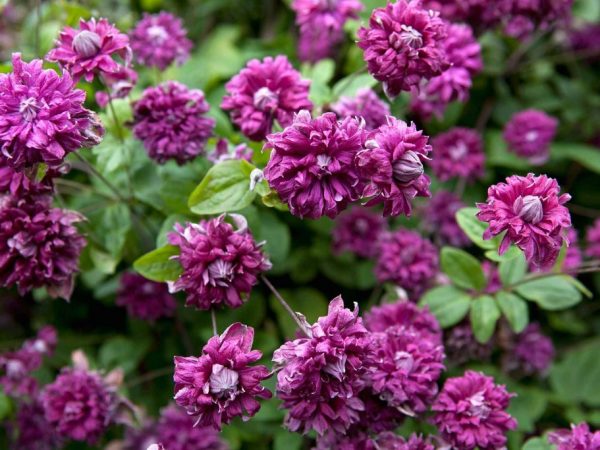
Clematis purpurea captivity elegance trimming group
Seat selection
The site for clematis Purpurea Plena Elegance should be well lit, but protected from the wind. Drafts are dangerous for this hybrid. An ideal place would be near the wall on the south or southeast side or in the center of the site on a small hill so that the roots do not rot. It is also desirable that groundwater does not pass close to the surface - no closer than 2 meters.
Preparation of planting material
This hybrid is most often bought in nurseries or online stores. In the latter case, the seedlings are sent by mail. They need to be inspected most carefully before landing. Taking out the planting material from the container, examine the roots. They should be dense, without outgrowths and "nodules". Their presence indicates root nematodes - such a plant should not be planted in the site.
Shoots should be sufficiently stiff at the base. Flexible and thin, they don't have enough strength to withstand the stress of landing. They should be kept for the first year in the house in a large flowerpot. When planting in spring, the seedling should not be with leaves - only with swollen buds. An autumn seedling is cut to 3-4 lower buds so that the plant directs all its forces to the formation of roots.
Landing technology
A hole for clematis is dug 60x60 in size with a depth of at least half a meter. Drainage from stones, gravel, coarse sand is laid at the bottom. A nutritious soil is laid on top.
The Purpurea Plena Elegance variety is undemanding to the composition of the soil. It can grow both on sandstones and on loamy soils with high acidity.
The following soil composition will be ideal for this hybrid:
- compost
- local soil
- peat
- coarse sand
- ash
Ash is added to reduce the acidity of the soil. Although this clematis can grow in acidic areas, you will not have to wait for dense greenery and abundant flowering on it. The plant will survive, but will not show its maximum decorative effect. Therefore, it is better to make the soil light, nutritious and neutral.
The planting hole is watered, the seedling is lowered, a support is installed next to it and they are covered with soil together. It is better to carry out the procedure in this order, so that later after planting it does not damage the roots of the bush. The ground near the trunk is slightly trampled down and must be mulched with fresh hay. This is necessary to protect the roots from overheating and drying out.
Care
Pruning
The third pruning group for this clematis is the simplest. The seedling is cut off almost entirely before wintering. Only a few living buds remain above the ground - a stump of 10-13 cm. The main thing is to cut the plant with pre-disinfected tools so as not to infect. Places of cuts are treated with a fungicide and covered with warm (not hot) wax from a candle.
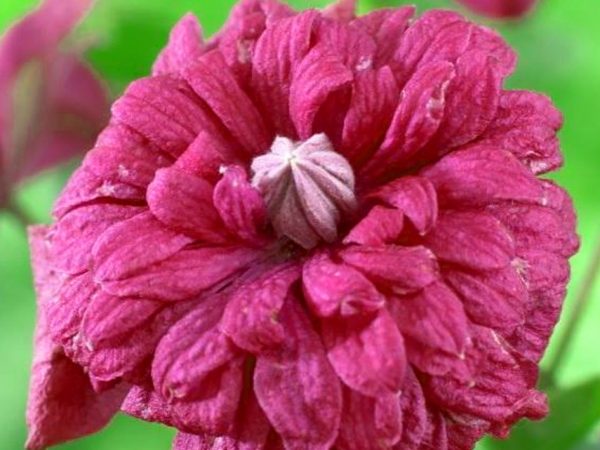
Clematis purpurea elegance
Watering
In the first year of planting, especially close attention is paid to watering. A young seedling is watered at least twice a week. During this period, the earth must not be overdried, otherwise the plant will not be able to form small roots. It is necessary to direct all the forces of the bush to the growth of the root system, it is even desirable to cut off the buds for the first two years, if they appear.
Water for the hybrid is taken from the rain, you can use melted snow. It will be difficult for the roots to assimilate ordinary tap water, it is too heavy and contains chlorine. The quality of water for irrigation is very important, especially for young seedlings. The assimilation of nutrients from the soil is directly dependent on this.
Top dressing
After planting in the first year, the plant should not be fed. The soil still contains enough trace elements necessary for growth and development. After overfeeding clematis, it is easy to destroy it, because an excess of nutrients is no less dangerous than their lack.
In the spring, all plants need nitrogen. It promotes the growth of greenery - shoots and leaves. For fast-growing vines, this is important, therefore, fertilizers such as are applied under clematis:
- ammonium sulfate;
- sodium or ammonium nitrate;
- urea (urea);
- calcium cyanamide.
During the budding period, clematis need phosphorus. Potassium is also needed for strength and longer flowering. Therefore, in the period from May to June, special mineral complexes or individual fertilizers are applied under the bush:
- copper or iron vitriol
- superphosphate
- phosphate rock
- potassium chloride
- potassium magnesium
- potassium carbonate (potash)
After flowering, the plant needs to recuperate and gain energy for a successful winter. During this period, it is good to feed the bush with organic matter - rotted manure. Poultry manure is also suitable, but it is concentrated, needs to be diluted. Organic fertilizers contain the entire range of trace elements necessary for clematis.
Various folk homemade dressings are also brought under the bushes. They are time-tested and used in any season - both spring and summer, and autumn.They cannot be overdose, and the benefits from them are no less than from purchased complexes. As a top dressing they use:
- fire coals;
- bread leaven (bread crusts are poured with water and left in a warm place for a week);
- onion husk infusion (20 g per 5 liters of boiling water);
- herbal infusion (the herb is placed in a barrel and filled with water, infused in a warm place for a month);
- potato broth;
- tea leaves or coffee grounds
Shelter for the winter
The Purpurea Plena Elegance variety differs from the others in its high resistance to frost. However, he still needs shelter for the winter. This is especially true for young seedlings that have not yet managed to build up a powerful root mass. It is necessary to cover the bush step by step according to the scheme:
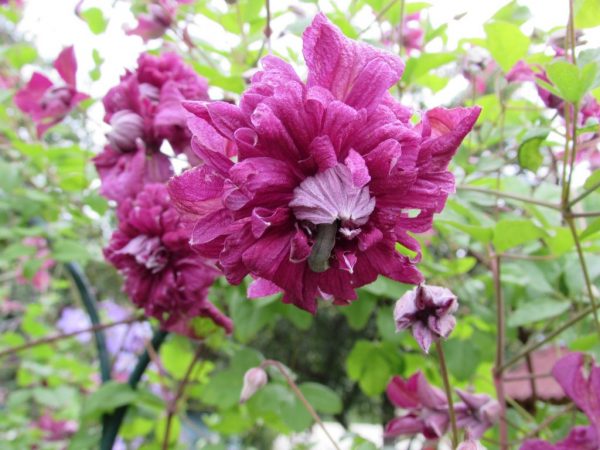
Clematis purpurea captivity photo and description of the variety
- Spread mulch around the root - hay, straw, dry leaves, spruce branches;
- Cover on top with several layers of sponbond;
- Cover with foil
- Press down the edges of the film with stones
After snow falls, make sure that it always covers the film. If necessary, throw snow from the edge of the site. In the spring, make sure that the melt water does not stagnate around the bush, otherwise it will rot and die.
Spring water protection
In spring, the main danger for clematis is flooding by melt water. To protect the plant, even in the fall, a bucket of peat or compost is poured under the bush, and a small mound is made. When the water has completely disappeared, it is raked and compared so that the bush has more room to grow.
Support
Purpurea Plena Elegance is a large and very dense shrub with stems up to 4 meters high, so it needs good support. It must be strong enough to withstand heavy weight and wind. It is better to plant the hybrid along walls, arbors or fences.
Important! The weight of the bush after the rain increases several times. This must be taken into account when installing the support under the clematis.
Mulching and loosening the soil
The roots of the hybrid are shallow, they are sensitive to overheating and drying out. Therefore, mulching is mandatory for the plant in any season. Hay or fresh grass, straw, sawdust, peat are spread under the bush. Beneficial microflora is formed under the mulch layer, which helps the plant to absorb nutrients.
Special attention should be paid to mulching with sphagnum moss. It is an excellent protection against moisture loss, a source of nutrition and soil disinfection. Moss does not allow root rot to develop - the main "enemy" of clematis. The radius of laying mulch around the trunk is 50-70 cm. Young bushes have a little less - 40-50 cm.
Reproduction
The hybrid is propagated vegetatively. The seed method is ineffective, because varietal properties are lost in this case. The rest of the methods are easy and effective, requiring little effort.
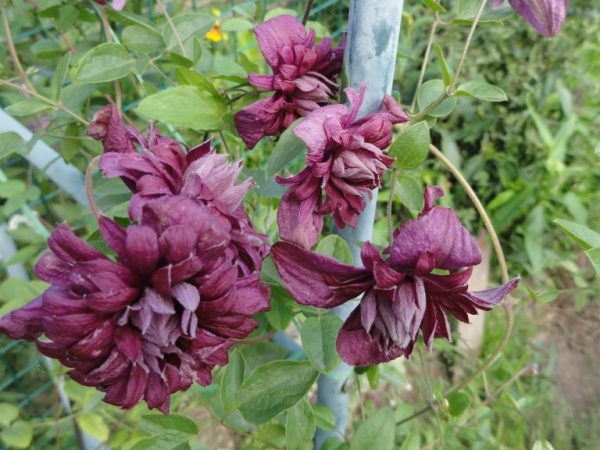
Clematis purpurea plena elegans description
Division of bushes
Clematis bushes become thickened over the years, bloom worse and get sick more often. They must be rejuvenated by dividing the bush, which is at the same time a way of reproduction. In the fall, the bush is dug out completely, the roots are shaken off the ground and cut into several parts with a sharp knife. The knife should first be disinfected with alcohol.
The cut sites are treated with Fitosporin to protect against bacteria. You can glue the cut with wax or garden varnish. Then the bushes are seated in separate pits. The distance between the bushes is made at least a meter, otherwise the roots will grow and interfere with each other.
The main bush is returned to its original place. It is only necessary to renew the land by adding nutritious soil, compost, rotted manure. After such manipulations, the old bush will rejuvenate and begin to bloom magnificently from next year.
Layers
The extreme shoots are taken away from the bush to the sides, bent to the ground and buried in, leaving the tops on the surface. The dug areas are watered abundantly. Watering should be regular to keep the ground moist all the time. Layers will take root in about a month, but for a long time they will feed on the mother bush.
Separating shoots in the first year of planting is not recommended.It is better to let them overwinter together, then the young plants will have a better chance of survival. After the snow melts, it will be clear which layers survived the cold. They can be separated and transplanted into a permanent place.
Cuttings
It is better to cut clematis in the spring before the leaves open. Young shoots are cut, divided into pieces, 3-4 buds in each. Rooted either in water or in a substrate. A few drops of Kornevin are added to the water. The substrate is prepared special, light and loose. Its composition is something like this:
- flower soil;
- perlite;
- vermiculite;
- coarse sand;
- peat
The cutting is placed in a substrate and placed under a lamp to set a constant temperature of + 25-27 ° C. In such conditions, with constant maintenance of moisture, the roots appear after 2-3 weeks. In the first year, the cuttings are transplanted into a greenhouse on the site or grown in a pot at home. In the second year, the seedlings are planted in open ground.
Diseases and pests
The hybrid is resistant to viral infections, but some types of diseases can affect it. This mainly happens due to overflow and insufficient lighting. Then pathogenic microflora begins to develop in the soil.
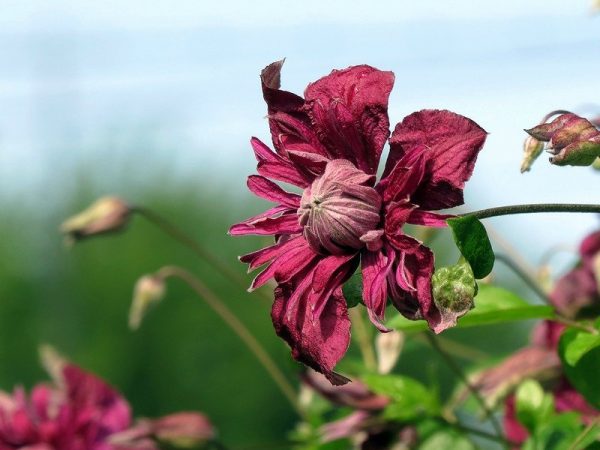
Clematis purpurea plena
Rot
If the bush is often in the shade, and when it is wet, then a grayish fluffy bloom appears on the leaves, shoots and roots. This is clematis rot. Liana stops growing, loses leaves, stops blooming. Young shoots die off, the plant risks dying.
Leaves and shoots are removed and burned away from the site, the plant is treated with Fundazol. The procedure is repeated twice with an interval of 2 weeks. Subsequently, they monitor the density of plantings, humidity and lighting.
Powdery mildew
This fungal disease is dangerous not only for clematis. Having struck a flower bush, it can spread to other garden and horticultural crops. The bush must be urgently sprayed with Skor or Topaz preparations. Repeat after 2 weeks to consolidate the result.
Harmful insects
Of insects, clematis is most often attacked by thrips, spider mites, aphids and nematodes. The plant is also annoyed by slugs and larvae of May beetles, which gnaw at the roots. Insects on the leaves are fought with insecticides: Biotlin, Actellik, Aktara, FAS. Spraying with a solution of digester soap also helps. It can be arranged for prophylaxis every 2 weeks.
Nematodes infect the roots, so it is difficult to spot them in time. The danger is that the nematodes cannot be defeated, the plant will have to be destroyed. The ground under it is disinfected several times. It is easier to deal with slugs - they can be collected by hand. The crushed eggshell scattered around the bushes helps in the fight against them.
Rodents
In winter, plants are often attacked by rodents. Field mice gnaw the stems and roots of the plant. For protection during the sheltering of the bush for the winter, branches of blackroot or granules of mouse poison are laid out on the shoots or near the trunk.
Use in landscape design
Hybrid Purpurea Plena Elegance is fast-growing, therefore it is suitable for gazebos and decorating the facades of houses. Looks great near the walls, near the porch of the house, as well as on high arches at the entrance to the site. It is used both singly and in combination with other horticultural crops.
The variety is successfully combined with ampel roses. The gazebos in their design look great, fragrant from spring to mid-autumn. Pergolas, mesh or building walls are suitable as supports for clematis. The main thing is that the support is reliable, for fidelity it is better to tie clematis to it.
Variety reviews
The variety received the most positive reviews at all exhibitions in which it participated. This clematis is very beautiful and does not require complex maintenance. The III pruning group makes it easier to prepare the plant for winter. Gardeners also note the high winter hardiness of the hybrid.
Clematis Purpurea Plena Elegance will adorn any garden. They can grow and bloom in all climatic zones, winter at -45 ° C and release 120 buds on each shoot.The splendor of flowering and unpretentiousness, disease resistance and winter hardiness have made this variety one of the most popular around the world.

